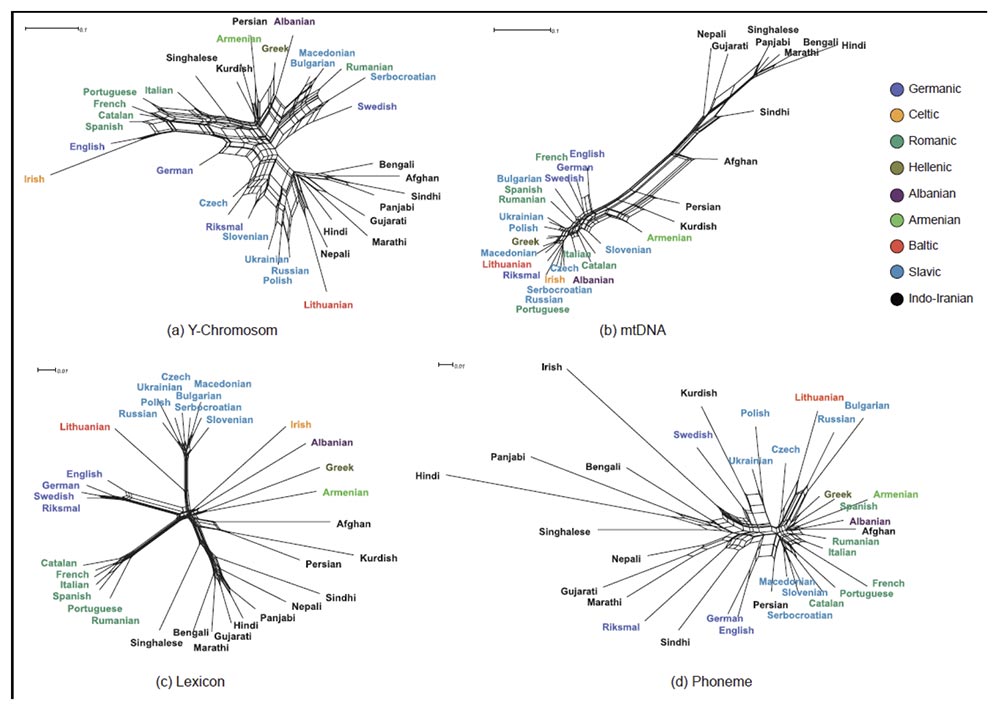New paper (behind paywall) Reconciling the father tongue and mother tongue hypotheses in Indo-European populations, by Zhang et al. National Science Review (2018) nwy083.
Interesting excerpts:
Here, we reassessed the correlation between genetic and linguistic characteristics in 34 modern IE populations (Fig. 1a), for which all four types of datasets (lexicon, phonemes, Y-chromosomal composition, and mitochondrial DNA (mtDNA) composition) are available. We assembled compositions of the Y-chromosomal and mtDNA haplogroups or paragroups from the corresponding IE populations, which reflect paternal and maternal lines, respectively (…)
Neighbour-Nets were constructed to delineate the differences between 34 IE population groups clustering at the genetic and linguistic levels (Fig. 2). The reticulations within each net reflect conflicting signals against tree-like structures and support incompatible groupings [21]. These structures are likely produced by potential horizontal transmissions between populations or languages such as admixture, and potential parallel evolution in linguistics as well [22]. The Neighbour-Net for Y-chromosomes with substantial reticulations shows complicated relationships among IE populations (Fig. 2a), indicating a substantial historical population contact and admixture among the males. In contrast, the Neighbour-Net for mtDNA in Fig. 2b clearly illustrates an East-West geographic polarization, indicating two major IE populations in matrilineages: Indo-Iranian and European. (…)

The language learning by local women could constitute the reason for unbalanced correlation of mtDNA to lexicon and phonemes. Due to the social prestige of male immigrants, their local spouses have to adopt the language of their husbands and pass it to future generations [6, 10, 15]. This process is second language acquisition and easily develops language fossilization [31]. The language fossilization is a linguistic mechanism that a learner of a second language tends to preserve some linguistic features of the first language, and develops a form of inter-language [31]. Under this circumstance, women can easily replace the lexicon from another [21], but attempt to retain local accents influenced by their native language [32]. In other words, women change to adopt the same word usage as their husbands in daily life but still speak using their own pronunciation. In mixed-language marriages with these male immigrants, women prefer to pass down their inter-languages to offspring [10, 33]. As a result, it yields the correlation between mtDNA and phonemes we observed. Hence, we courageously proposed a hypothetical scenario in Indo-European populations that lexical system of language dominated by their father, while the phonemic system of language determined by their mother.
I am not a fan of this kind of statistical studies for Comparative Grammar, and there are many pitfalls just by looking at this paper superficially: use of modern languages and modern haplogroup distributions, improper classification of phonemes – as is usual in glottochronological studies – , etc… Which render their results ipso facto unacceptable.
But just yesterday I was discussing where the Copenhagen group and their fans were going to end up when Yamna samples turn out not to be the origin of haplogroup R1a-Z645 expansion, and Anthony’s proposal of a patron-client relationship came up. Since the Danish workgroup is always one step behind, such a reactionary view seems like a reasonable assumption for the future.
This mother tongue vs. father tongue theory is another good possibility for what we are going to see, then, when they use e.g. the exogamy of eastern Corded Ware groups with Yamna to explain the adoption of the language. Maybe that’s what Kristiansen’s invented Yamna → Corded Ware arrows mean… Anything to prove that Corded Ware peoples were Indo-European speakers.
Related
- Evolutionary forces in language change depend on selective pressure, but also on random chance
- Forces driving grammatical change are different to those driving lexical change
- Statistical methods fashionable again in Linguistics: Reconstructing Proto-Australian dialects
- Yet another Bayesian phylogenetic tree – now for Dravidian
- The origin and expansion of Pama–Nyungan languages across Australia